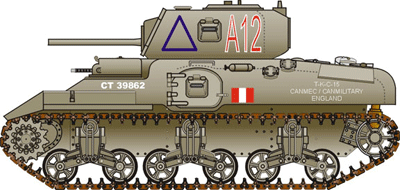
Try Amazon Audible Premium Plus and Get Up to Two Free Audiobooks
Tank, Cruiser, Ram

Ram Mk. I
German military successes in the early days of WWII led to a realization that British tank production would be stretched to the limit to equip their own army, let alone Canadian Army requirements. With the fall of France and the danger of an invasion of Great Britain, it was further decided that more military production should be concentrated in Canada. With plans to mobilize two armoured divisions herself, Canada's cruiser tank requirements would be in the area of 1,000 vehicles, and there was absolutely no hope that Britain would be able to supply the necessary tanks. British and Canadian Army officials saw serious design flaws in the U.S. medium M3 tank with its hull mounted main gun of limited traverse. To overcome those design flaws, the design and production of a cruiser tank in Canada was therefore undertaken. The design team appreciated the robust reliability of the M3 chassis and chose to incorporate it in the Canadian cruiser, in combination with a hull and turret that would meet Canadian/British requirements. A running prototype was completed in June 1941. As the 6pdr main gun drawings had not arrived from Great Britain, it was decided to mount the 2pdr gun in the first fifty vehicles which would be called the Ram I. In the summer of 1941, the Ram I prototype underwent trials at Aberdeen Proving Grounds in the U.S. Whether or not the Ram design influenced the U.S. T6 (M4 prototype) is still open to debate. The two tanks certainly shared similarities in design. One notable difference however, was that the driver's station in the Ram followed British practise and was on the right side of the tank. The Americans eventually gave the Ram Cruiser the paper designation M4A5. Distinguishing features of the Ram I were the 2pdr main gun mounted in a cast turret that had a flat bolted front plate, a cast upper hull with side sponson doors incorporating protectoscopes, an auxiliary MG turret mounted on the hull to the left of the driver position and the complete American M3 medium tank chassis. By the end of 1942, 40 of the original 50 Ram Is had been shipped overseas to Great Britain to partially equip Canadian armoured units. It was never to see action, and was used strictly for training purposes. The Ram series was powered by the Continental R-975 radial engine which gave it a maximum speed of 25mph. Armour thickness varied between a maximum of 87mm and a minimum of 25mm. It was crewed by five; a commander, gunner, loader, driver and hull MG gunner (co-driver).

Ram Mk. II
In January 1942, after the completion of the first fifty Rams armed with 2pdr guns, full production started with Rams equipped with the 6pdr gun. These were all designated "Ram II". During its production life, the Ram II went through a variety of modifications, mostly as a result of user reports from the field. The following tables, using War Department numbers, illustrate the major modifications the Ram underwent.
| Ram II Modifications | From |
| Side doors removed from hull |
CT-40131
|
| Pistol ports added in hull in place of side doors |
CT-40131
|
| Pistol ports eliminated |
CT-40546
|
| Access plate in turret rear eliminated and belly hatch provided |
CT-159502
|
| Auxiliary machine gun turret eliminated |
CT-159502
|
| Improved 6pdr gun mantlet |
CT-159599
|
| Improved R-975-CI engine, new mufflers, improved air cleaners, improved clutch, and transmission cooler |
Late production
|
| Improved volute suspension brackets with trailing return rollers and heavier springs, C.D.P. tracks |
Very late production
|
|
|
|
| 6pdr gun with gyro-stabilizer; splash beading added around turret |
CT-39831 - CT-40937 CT-159402 - CT-160193 |
 |
This illustration depicts an early Ram II of 'A' Sqn as it may have appeared as a tank of the Grey and Simcoe Foresters. This regiment, together with the 16/22 Saskatchewan Horse and Halifax Rifles, constituted 2nd Army Tank Brigade which was originally formed in Canada. The Grey and Simcoe Foresters were the junior regiment in the brigade and therefore the tac signs were painted blue. |
The majority of the Rams were shipped to the United Kingdom where they equipped the Canadian armoured units for training purposes. The Ram never saw use in action as a cruiser tank as it was superceded by the Sherman series in Canadian useage. The decision to terminate Ram production was made as early as August 1942, when it became apparent that U.S. production of the M4 series would be adequate to cover Canadian needs. A decision was made to produce the M4A1 tank in Canada, in the interests of standardization, but ultimately, production of the Ram continued until July 1943.
The Ram is perhaps best remembered as the basis for the Kangaroo conversion, and as the Ram Observation Post in Canadian Sexton SP artillery units. It saw action in North-West Europe in both these guises.
While the Ram cruiser proved to be a robust design, it was limited to further development by a turret ring that was too small to easily mount a 75mm gun turret. Interestingly enough, certain Canadian calls for a larger turret ring in the initial design had gone unheeded by the design team, which faithfully followed British practise of the day whereby all cruiser tanks would need only be armed with the 6pdr main gun. Such lack of vision was to restrict development of not only the Ram, but of several British cruisers also.

© Chris Johnson, 1997-2002
Index

